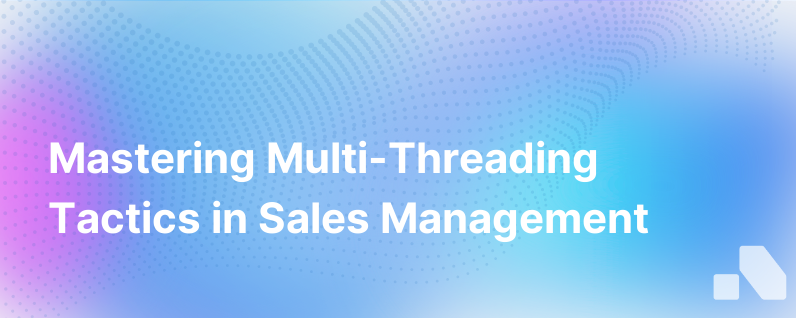Multi Threading In Sales
Published on August 2, 2023 by David Zhang
Multi-threading in sales is an increasingly recognized approach in the complex landscape of B2B deals. As purchasing decisions become more cross-functional, relying on single points of contact or "lone wolf strategies" is precarious and can lead to stalled or lost deals. Multi-threading isn't a tactic, it's a comprehensive strategy that involves engaging multiple stakeholders across an organization.
In this elaborate guide, let's unfold the layers of multi-threading in sales and understand why it is critical for today's sales professionals, how multi-threading is executed, and the areas that can create multi-threading success in sales interactions.
Understanding Multi-Threading in Sales
Multi-threading refers to the practice of building relationships and parallel lines of communication with multiple decision-makers and influencers within a client organization. It is a richer sales engagement technique than traditional single-threaded approaches, which rely on one-to-one relationships.
The reasons for incorporating multi-threading in your sales strategy are compelling and include diversification of risk, deeper account penetration, and amplified trust. If your sole contact leaves the company or the project, without multi-threaded relationships, the deal can quickly disintegrate. Furthermore, multiple advocates within an organization can champion your solution, accelerating the decision process and expanding potential opportunities.
The Importance of Multi-Threading in B2B Sales
Let's begin with the "why" behind multi-threading. B2B sales involve multiple stakeholders with various roles, pain points, and agendas. The complexity and investment involved in enterprise sales mean that the impacts are wide-ranging, thus requiring consensus. IDC data indicates that on average, seven people are involved in buying decisions for companies with 100-500 employees; this may increase for larger companies.
With such dynamics involved, it behooves sales professionals to build multi-threaded relationships to:
- Reduce the risks associated with turnover or reorganization
- Navigate corporate politics and power structures
- Customize value propositions for different stakeholders
- Gain comprehensive insights into organizational needs
- Foster client resilience by distributing knowledge and advocacy
Crafting a Multi-Threading Sales Strategy
Building a robust multi-threading sales strategy involves the following steps:
-
Research and Identify Stakeholders: Use tools like LinkedIn, organizational charts, and industry databases to identify influencers, decision-makers, and end-users within the organization.
-
Engage on Multiple Levels: Taylor outreach to connect with stakeholders across different seniority levels and functions. Craft messages that resonate with individual concerns and objectives.
-
Leverage Inside Champions: When you have one contact firmly advocating for you, ask for introductions to others, capitalizing on the good faith you've built.
-
Customize Your Value Proposition: Understand how your product or service impacts different roles and departments, then tailor your sales conversations to address specific functional benefits.
-
Create a Narrative: Weave a story that ties the value for each stakeholder into a unified vision that encompasses the holistic benefit to the company.
-
Coordinate Internal Communication: Ensure that everyone on the sales team is aware of all touchpoints and communications to present a unified, coherent approach to the client.
Execution of Multi-Threading in Sales
A purposeful multi-threaded approach isn't shotgun outreach; it's precise and thoughtful engagement. Here's how to ensure tactful execution:
-
Host Multi-Stakeholder Meetings: Where appropriate, bring multiple client stakeholders together to foster cross-functional conversations.
-
Map Pain Points to Solutions: Clearly align solutions to the distinct challenges of various stakeholders.
-
Schedule Regular Touchpoints: Keep in regular contact with all involved, providing updates, insights, and support as needed.
-
Encourage Peer-to-Peer Conversations: If possible, connect client-side peers with their counterparts in your organization, such as connecting your CTO with theirs for technical alignment.
Challenges of Multi-Threading and How to Overcome Them
Here are common challenges sales teams face with multi-threading, along with strategies to address them:
Resistance from Gatekeepers: Some contacts may be reluctant to facilitate introductions. To overcome this, demonstrate the benefits of broader involvement for advancing the project.
Navigating Complex Organizations: Large companies can be mazes. Keep a clear record of interactions, decision-makers, and internal linkages, updating a CRM regularly.
Maintaining Consistency: Poor internal communication may lead to disjointed client interactions. Have a central repository of information and ensure all team members are onboarded with account specifics.
Providing Individualized Attention: Customizing communication for many distinct stakeholders is labor-intensive. Systems and templates informed by relationship analytics can streamline this process.
Leveraging Technology for Successful Multi-Threading
Advancements in CRM and sales enablement tools have been a boon for executing multi-threading. Sales teams can track interactions, determine the next best action, and manage extensive stakeholder networks using AI-powered platforms like Aomni.
Aomni, for instance, assists sales reps in account planning and segmenting by analyzing data trends and suggesting potential stakeholders for engagement. Such tools provide real-time insights to personalize sales tactics across a vast array of contacts.
Conclusion
In today's multifaceted B2B environment, multi-threading is not optional; it's the groundwork of contemporary sales. By connecting with various individuals within an organization, you create a web of relationships that supports and propels deals forward. By strategically engaging multiple stakeholders with tailored messaging, consistent follow-up, and leveraging sophisticated sales tools, like Aomni, you set the stage for sales success that is resilient and expansive. Remember, the depth of your relationships often determines the height of your sales success.